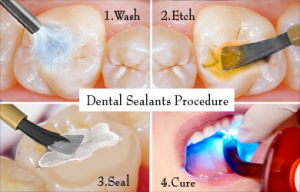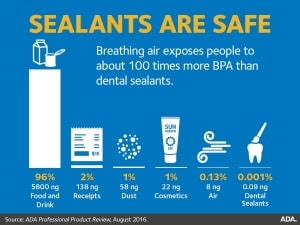By Arthur Kezian
What is a dental sealant? Why is it important? What are the benefits? All of these could be questions you may have if you heard your children or someone you know needs them. For starters, dental sealants are thin coatings made of plastic material that are brushed onto the surface area of teeth to have fissures and pits sealed off, hence the name sealant.
[fusion_builder_container hundred_percent=”yes” overflow=”visible”][fusion_builder_row][fusion_builder_column type=”1_1″ background_position=”left top” background_color=”” border_size=”” border_color=”” border_style=”solid” spacing=”yes” background_image=”” background_repeat=”no-repeat” padding=”” margin_top=”0px” margin_bottom=”0px” class=”” id=”” animation_type=”” animation_speed=”0.3″ animation_direction=”left” hide_on_mobile=”no” center_content=”no” min_height=”none”]

Sealants are usually intended for children and teens because they are more susceptible to having cavities. For those who are cavity-prone, sealants are placed as a preventative measure. For children, sealants are recommended once their permanent teeth come in. Once sealants are placed on the teeth, they block off sugars and food particles from getting trapped in the fissures and pits of the teeth. In doing so, sealants protect the teeth from possible cavities. By placing sealants you can reduce the chances of getting cavities by about 80%!
Adults are possible candidates for sealants as well if they have a clean record. Placing a sealant on a tooth that has decay will not help the tooth or clean out the decay. Sealants must be placed on “virgin” teeth to prevent them from turning into decay.
Sealants can last up to ten years if taken care of properly. They should be checked every six months to a year during routine dental visits to make sure they are not wearing away. Brushing hard, chewing, biting, grinding, and clenching are all maneuvers that can wear away the sealants over time.
[/fusion_builder_column][fusion_builder_column type=”1_1″ background_position=”left top” background_color=”” border_size=”” border_color=”” border_style=”solid” spacing=”yes” background_image=”” background_repeat=”no-repeat” padding=”” margin_top=”0px” margin_bottom=”0px” class=”” id=”” animation_type=”” animation_speed=”0.3″ animation_direction=”left” hide_on_mobile=”no” center_content=”no” min_height=”none”]

As important as sealants are, not too many children have them. As a parent, it is important to be informed about this procedure and talk to your child’s dentist about it, if they don’t mention it first. Some parents might already know about sealants and may be hesitant about them because they have heard about BPA in sealants. Although this is true, there is more to the story. Dental sealants contain compounds in them that turn into BPA when saliva is mixed due to a chemical reaction. However, the amount of exposure is so little, it is almost non-evident.
If you are worried about the exposure to BPA, you can ask your cosmetic dentist to rinse, wash, and scrub the sealants after they are placed. By doing so, most of the compounds can be eliminated.
Talk to your dentist about sealants and how they can protect your teeth in the long-run. If you don’t have cavities and have a clean record, you can maintain it with sealants. As far as your children, they too can have the possibility of a clean record if sealants are applied from a young age and looked after routinely. They can keep smiling knowing they are cavity-free and you can smile knowing you can save your money![/fusion_builder_column][/fusion_builder_row][/fusion_builder_container]
Dr. Arthur A. Kezian DDS 443 N. Larchmont Blvd Los Angeles, CA 90004 (323) 467-2777
